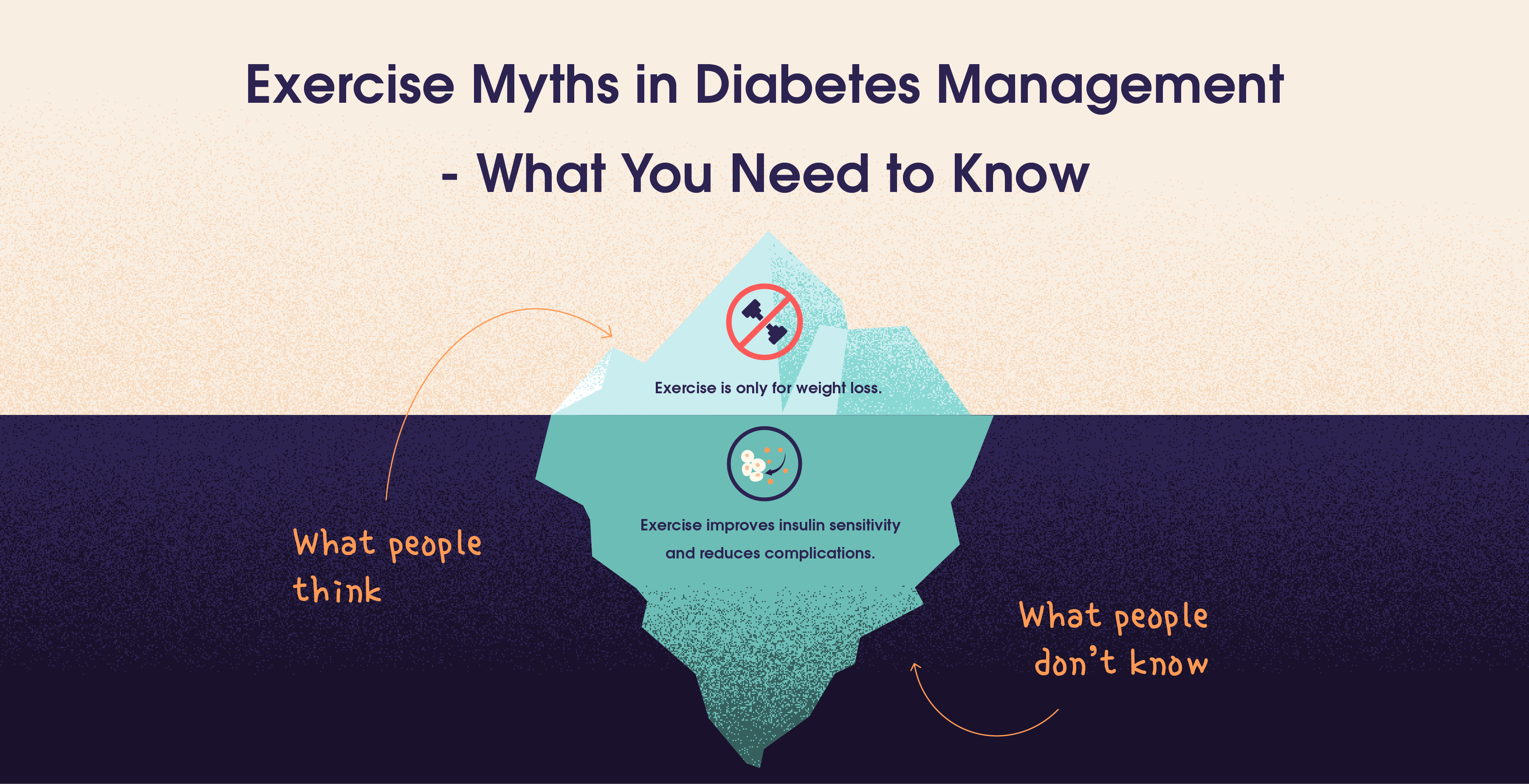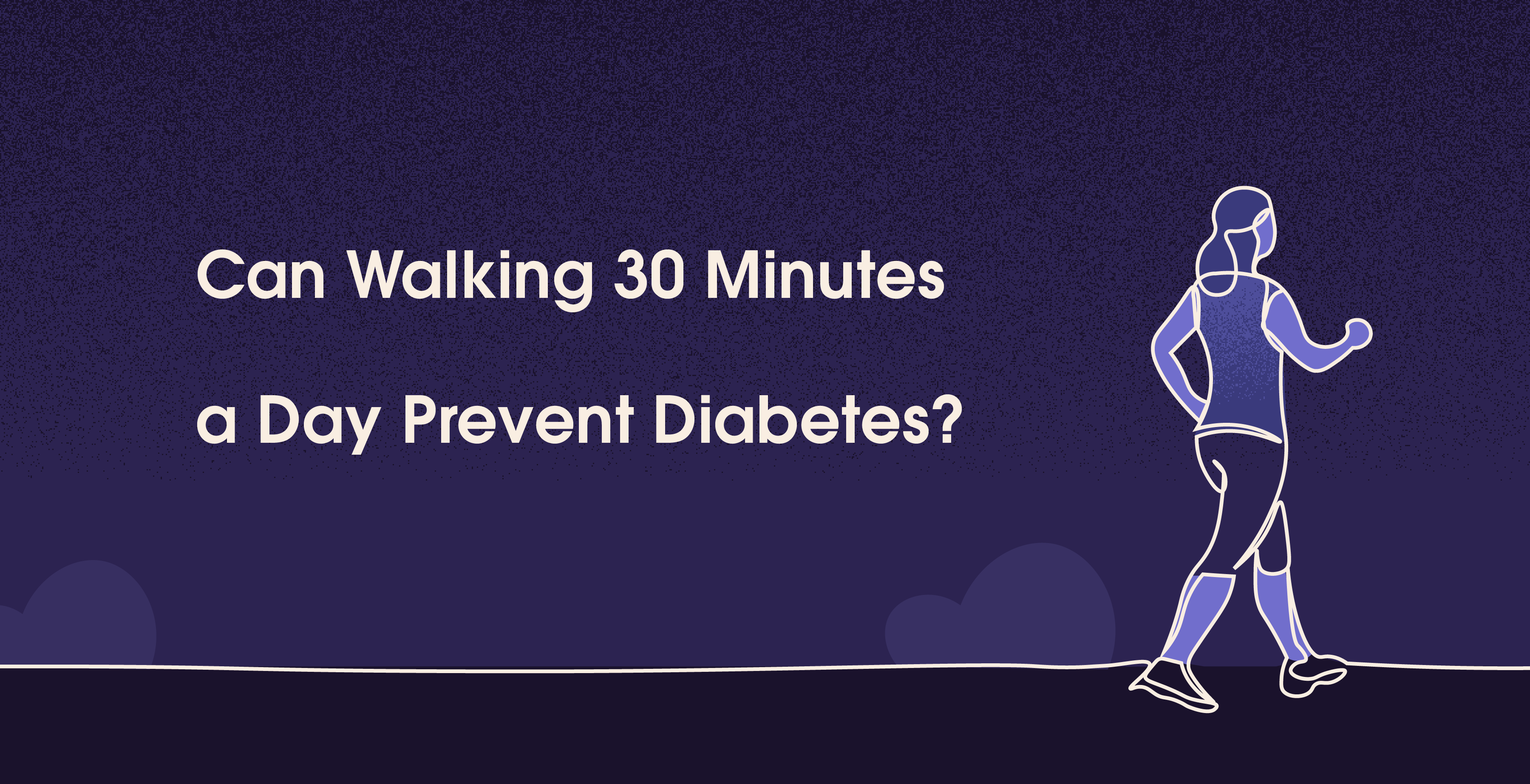Exercise Myths in Diabetes Management - What You Need to Know
Feb 17, 2025
Aparna Hurtis



Table Of Contents
Managing diabetes can feel challenging or overwhelming, especially when it comes to exercise. When you are someone who has a hard time exercising, all the advice out there it is hard to know what is true and what is a myth.
We are here to help you separate fact from fiction. Whether you’re living with diabetes or caring for someone who has diabetes or someone who has a family history and is looking for a solution this blog will help you in clearing up common exercise misconceptions and will provide you with practical tips to help you stay active and healthy.
Highlights
Myth 1: Exercise isn’t necessary if you’re on medication.
- Truth: Exercise improves insulin sensitivity and reduces complications.Myth 2: Avoid exercise if your blood sugar is high.
- Truth: Moderate exercise is safe for most people with diabetes.Myth 3: Only cardio works for diabetes management.
- Truth: Strength training is equally important for glucose control.Myth 4: You can’t exercise if you have diabetes complications.
- Truth: Modified exercises can still be safe and beneficial.Myth 5: Exercise always lowers blood sugar.
- Truth: Intense exercise can temporarily raise blood sugar.Myth 6: You need to exercise for hours to see benefits.
- Truth: Even 10 minutes of activity can make a difference.Myth 7: Exercise is only for weight loss.
- Truth: Exercise improves insulin sensitivity, energy, and heart health.Practical Tips: Start slow, stay hydrated, wear proper footwear, and track progress using tools like the TRST Urth app.
Myth 1 - Exercise Isn’t Necessary If You’re on Medication
The truth is Medication is an important part of managing diabetes but it’s not a substitute for exercise. Physical activity helps your body use insulin more effectively, it lowers blood sugar levels, and improves overall cardiometabolic health. According to the American Diabetes Association (ADA), regular exercise can reduce the risk of complications like heart disease, nerve damage, and kidney problems.
Here’s what you can do - Aim for at least 150 minutes of moderate-intensity exercise per week, such as brisk walking, swimming, or cycling. If you’re new to exercise it is best to start slow and gradually increase your activity level. Always consult your healthcare provider before you make any significant changes to your routine.
Myth 2 - You Should Avoid Exercise If Your Blood Sugar Is High
While extremely high blood sugar levels (Hyperglycemia) can make exercise risky, moderate physical activity is generally safe and beneficial for most people with diabetes. Exercise will help lower blood sugar by increasing insulin sensitivity and allowing your muscles to use glucose for energy.
Here’s what you can do - Check your glucose levels before and after exercise. If your levels are above mg/dL and you have ketones, avoid vigorous activity and consult with your doctor. For levels between 100-250 mg/dL, light to moderate exercise is usually recommended and safe. Using tools like the trst urth app along with your Continuous Glucose Monitor (CGM) can help you in monitoring your glucose levels and track how your body responds to different activities.
Myth 3 - Only Cardio Works for Diabetes Management
Cardio exercises like walking, jogging, and cycling are indeed great for managing blood sugar, strength training is equally important. Building muscle mass will help your body store and use glucose more effectively, which can lead to better long-term blood sugar control.
Here’s what you can do - Incorporate a mix of cardio and strength training into your routine. Try activities like weightlifting, resistance band exercises, or bodyweight workouts (eg - squats, push-ups). The ADA recommends strength training at least twice a week for people with diabetes.
Myth 4 - You Can’t Exercise If You Have Diabetes Complications
With certain complications like severe neuropathy or retinopathy, it may require modifications, but most people with diabetes can still exercise safely. In fact, staying active can help in managing complications and improve quality of life.
Here’s what you can do - Work with your healthcare team or with a personal trainer to create a personalized plan. If you have foot neuropathy, opt for low-impact activities like yoga or swimming. If you have vision problems, choose well-lit, familiar environments for exercise. The key is to stay active while prioritizing safety.
Myth 5 - Exercise Always Lowers Blood Sugar
Exercise does typically lower blood sugar, intense or prolonged activity can sometimes cause it to rise temporarily. This is because your body releases stress hormones like adrenaline, which can increase glucose production.
Here’s what you can do - Monitor your blood sugar before, during, and after exercise - especially if you’re trying a new activity or increasing intensity. Keep a snack on hand in case your levels are too low. Tools like the trst urth app paired with a CGM can help you in tracking patterns and make informed decisions about your exercise routine.
Myth 6 - You Need to Exercise for Hours to See Benefits
You don’t need to spend hours at the gym to reap the benefits of exercise. Even short bursts of activity can make a difference. Studies show that just 10 minutes of moderate exercise can help lower blood sugar levels.
Here’s what you can do - Break up your exercise into smaller sessions throughout the day. For example, take a 10-minute break after each meal or do a quick workout during your lunch break. Consistency is more important than duration.
Myth 7 - Exercise Is Only for Weight Loss
Exercise can help with weight management, the benefits go far beyond shedding pounds. Regular physical activity improves insulin sensitivity, reduces stress, boosts energy levels, and supports heart health - all of which are crucial for diabetes management.
Here’s what you can do - Focus on how exercise makes you feel, and not just how it affects your weight. Celebrate non-scale victories like improved energy, better sleep, and lower blood sugar readings. Remember, every step counts!
Practical Tips for Safe and Effective Exercise
Start Slow -
If you’re new to exercise, begin with low-impact activities like walking or stretching. Gradually increase intensity as your fitness improves.
Stay Hydrated -
Dehydration can affect blood sugar levels, so drink plenty of water before, during, and after exercise.
Wear Proper Footwear -
Protect your feet by wearing comfortable, supportive shoes, especially if you have neuropathy.
Listen to Your Body -
If you feel dizzy, lightheaded, or unusually tried, stop exercising and check your blood sugar,
Track Your Progress -
Use tools like the trst urth app to monitor your glucose levels, activity, and overall health. This can help you identify patterns and make adjustments as needed.
Final Thoughts
Exercise is a powerful tool for managing your diabetes and will improve your cardiometabolic health, but it’s important to separate fact from fiction. By debunking these common myths, we hope to empower you to take control of your health and stay active with confidence.
At trst health, we’re committed to helping you live your best life. Whether you’re trying to track your glucose levels or explore our resources or build new habits, we’re here to support you every step of the way.
Ready for the next step? Download the trst urth app today and start your journey towards a better you! Your future self will thank you!
Managing diabetes can feel challenging or overwhelming, especially when it comes to exercise. When you are someone who has a hard time exercising, all the advice out there it is hard to know what is true and what is a myth.
We are here to help you separate fact from fiction. Whether you’re living with diabetes or caring for someone who has diabetes or someone who has a family history and is looking for a solution this blog will help you in clearing up common exercise misconceptions and will provide you with practical tips to help you stay active and healthy.
Highlights
Myth 1: Exercise isn’t necessary if you’re on medication.
- Truth: Exercise improves insulin sensitivity and reduces complications.Myth 2: Avoid exercise if your blood sugar is high.
- Truth: Moderate exercise is safe for most people with diabetes.Myth 3: Only cardio works for diabetes management.
- Truth: Strength training is equally important for glucose control.Myth 4: You can’t exercise if you have diabetes complications.
- Truth: Modified exercises can still be safe and beneficial.Myth 5: Exercise always lowers blood sugar.
- Truth: Intense exercise can temporarily raise blood sugar.Myth 6: You need to exercise for hours to see benefits.
- Truth: Even 10 minutes of activity can make a difference.Myth 7: Exercise is only for weight loss.
- Truth: Exercise improves insulin sensitivity, energy, and heart health.Practical Tips: Start slow, stay hydrated, wear proper footwear, and track progress using tools like the TRST Urth app.
Myth 1 - Exercise Isn’t Necessary If You’re on Medication
The truth is Medication is an important part of managing diabetes but it’s not a substitute for exercise. Physical activity helps your body use insulin more effectively, it lowers blood sugar levels, and improves overall cardiometabolic health. According to the American Diabetes Association (ADA), regular exercise can reduce the risk of complications like heart disease, nerve damage, and kidney problems.
Here’s what you can do - Aim for at least 150 minutes of moderate-intensity exercise per week, such as brisk walking, swimming, or cycling. If you’re new to exercise it is best to start slow and gradually increase your activity level. Always consult your healthcare provider before you make any significant changes to your routine.
Myth 2 - You Should Avoid Exercise If Your Blood Sugar Is High
While extremely high blood sugar levels (Hyperglycemia) can make exercise risky, moderate physical activity is generally safe and beneficial for most people with diabetes. Exercise will help lower blood sugar by increasing insulin sensitivity and allowing your muscles to use glucose for energy.
Here’s what you can do - Check your glucose levels before and after exercise. If your levels are above mg/dL and you have ketones, avoid vigorous activity and consult with your doctor. For levels between 100-250 mg/dL, light to moderate exercise is usually recommended and safe. Using tools like the trst urth app along with your Continuous Glucose Monitor (CGM) can help you in monitoring your glucose levels and track how your body responds to different activities.
Myth 3 - Only Cardio Works for Diabetes Management
Cardio exercises like walking, jogging, and cycling are indeed great for managing blood sugar, strength training is equally important. Building muscle mass will help your body store and use glucose more effectively, which can lead to better long-term blood sugar control.
Here’s what you can do - Incorporate a mix of cardio and strength training into your routine. Try activities like weightlifting, resistance band exercises, or bodyweight workouts (eg - squats, push-ups). The ADA recommends strength training at least twice a week for people with diabetes.
Myth 4 - You Can’t Exercise If You Have Diabetes Complications
With certain complications like severe neuropathy or retinopathy, it may require modifications, but most people with diabetes can still exercise safely. In fact, staying active can help in managing complications and improve quality of life.
Here’s what you can do - Work with your healthcare team or with a personal trainer to create a personalized plan. If you have foot neuropathy, opt for low-impact activities like yoga or swimming. If you have vision problems, choose well-lit, familiar environments for exercise. The key is to stay active while prioritizing safety.
Myth 5 - Exercise Always Lowers Blood Sugar
Exercise does typically lower blood sugar, intense or prolonged activity can sometimes cause it to rise temporarily. This is because your body releases stress hormones like adrenaline, which can increase glucose production.
Here’s what you can do - Monitor your blood sugar before, during, and after exercise - especially if you’re trying a new activity or increasing intensity. Keep a snack on hand in case your levels are too low. Tools like the trst urth app paired with a CGM can help you in tracking patterns and make informed decisions about your exercise routine.
Myth 6 - You Need to Exercise for Hours to See Benefits
You don’t need to spend hours at the gym to reap the benefits of exercise. Even short bursts of activity can make a difference. Studies show that just 10 minutes of moderate exercise can help lower blood sugar levels.
Here’s what you can do - Break up your exercise into smaller sessions throughout the day. For example, take a 10-minute break after each meal or do a quick workout during your lunch break. Consistency is more important than duration.
Myth 7 - Exercise Is Only for Weight Loss
Exercise can help with weight management, the benefits go far beyond shedding pounds. Regular physical activity improves insulin sensitivity, reduces stress, boosts energy levels, and supports heart health - all of which are crucial for diabetes management.
Here’s what you can do - Focus on how exercise makes you feel, and not just how it affects your weight. Celebrate non-scale victories like improved energy, better sleep, and lower blood sugar readings. Remember, every step counts!
Practical Tips for Safe and Effective Exercise
Start Slow -
If you’re new to exercise, begin with low-impact activities like walking or stretching. Gradually increase intensity as your fitness improves.
Stay Hydrated -
Dehydration can affect blood sugar levels, so drink plenty of water before, during, and after exercise.
Wear Proper Footwear -
Protect your feet by wearing comfortable, supportive shoes, especially if you have neuropathy.
Listen to Your Body -
If you feel dizzy, lightheaded, or unusually tried, stop exercising and check your blood sugar,
Track Your Progress -
Use tools like the trst urth app to monitor your glucose levels, activity, and overall health. This can help you identify patterns and make adjustments as needed.
Final Thoughts
Exercise is a powerful tool for managing your diabetes and will improve your cardiometabolic health, but it’s important to separate fact from fiction. By debunking these common myths, we hope to empower you to take control of your health and stay active with confidence.
At trst health, we’re committed to helping you live your best life. Whether you’re trying to track your glucose levels or explore our resources or build new habits, we’re here to support you every step of the way.
Ready for the next step? Download the trst urth app today and start your journey towards a better you! Your future self will thank you!
Table Of Contents
Table Of Contents
Table Of Contents
Read More


Apr 2, 2025
Sayfali Rawlani


Feb 10, 2025
Aparna Hurtis


Feb 4, 2025
Sayfali Rawlani



Company
Copyright © 2025 trst health. All right reserved.

